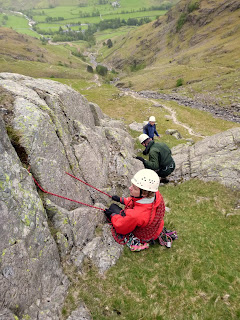Some time ago, we were contacted by Josh Abrahams - Safety Officer of the Cambridge University Hill Walking Club who organise club meets around the UK for their members.
The club had planned a visit to The Lake District for this weekend. Some members were planning to go hill walking for the entire time. Others fancied having a go at Scrambling. Josh found our website on the internet and liking what he saw, contacted Iain to see if we would arrange a Scrambling Skills Training Course for club members.
So what is scrambling? Well, it could be described as easy rock climbing involving the use of three or four points of contact depending on the angle of the rock. Scrambles are usually rocky ridges or buttresses - rather like the ground seen here in photo one.
This group wanted to learn the skills of scrambling so that they could go off and do the sport for themselves. Iain started off by getting them to understand the skill of "spotting" which involves safeguarding each other on easy ground without the use of a rope. They are all practicing this skill in photo one.
In photo two, Josh Abrahams - the Hill Walking Club safety Officer is practicing a body or "indirect" belay. This photo was taken some time later on and we had moved from spotting on to using a whole range of techniques designed to safeguard scramblers by use of a climbing rope.
So why use a climbing rope when scrambling? Well, as a rule of thumb, the rope should be used when there is the chance of a slip turning into something more serious ie a fall and injury. The use of a climbing rope should add security to a scrambling or mountaineering scenario but it will only do so if used correctly.
For a start there is no point in employing the use of a rope if it is going to be allowed to be "slack" in a situation where someone could slip - the rope should be kept tight to prevent a slip becoming anything more! What Josh was doing here was keeping the rope tight on the other two group members who were ascending relatively "easy" ground where a slip was unlikely - but if it occurred, this type of belay would be adequate to prevent it turning into anything worse! Body belays should only be used on the easiest of scrambling terrain!
We had three people in this group (there were actually two groups of three out on both days - each with a Mountaineering Instructor) and all three wanted to have a go at practicing the various techniques involved when scrambling on potentially serious terrain.
Firstly, after coaching the trio in Spotting, Iain demonstrated short roping, tying on to the rope, taking chest coils & locking them off, moving together and pitching (ie leaving the group in one place whilst he ascended a steeper section of the scramble before belaying them all up ( safeguarding them by keeping them tight on the rope whilst they ascended the "steeper" sections). We also looked at descending using the various methods of belaying and in photo three Josh uses a "direct" belay to protect Sam & Ben who are descending a steep gully below. We also looked at the method of the leader protecting themselves when they have lowered others down a section of scrambling ground too steep to be soloed down safely. Soloing is climbing of scrambling without the use of a rope and is inadvisable - unless you know your limitations!!
The final photo from this post about day one of a Scrambling Skills Training Course in The Lake District sees Ben testing out Sam's "locked off "coils.
Josh is clearly enjoying watching what is happening although Ben neither managed to throttle Sam or pull him over despite being a strong lad!
Why had Sam taken chest coils in the first place? Well, as a rule, when leading a scramble you want to keep your seconds as close to you as possible when ever possible - ie on a short rope! and we had a full 50 metres of rope to play with! You also need to lock off your chest coils to avoid them being pulled tight around you upper body/neck!
The lads had a great day out with Iain at Tarn Crag in Langdale learning basic scrambling skills which would all be put to good practice on day two in the Coniston area - the subject of the second report about this weekend Scrambling Skills Training Course in The Lake District.
Subscribe to:
Post Comments (Atom)





No comments:
Post a Comment